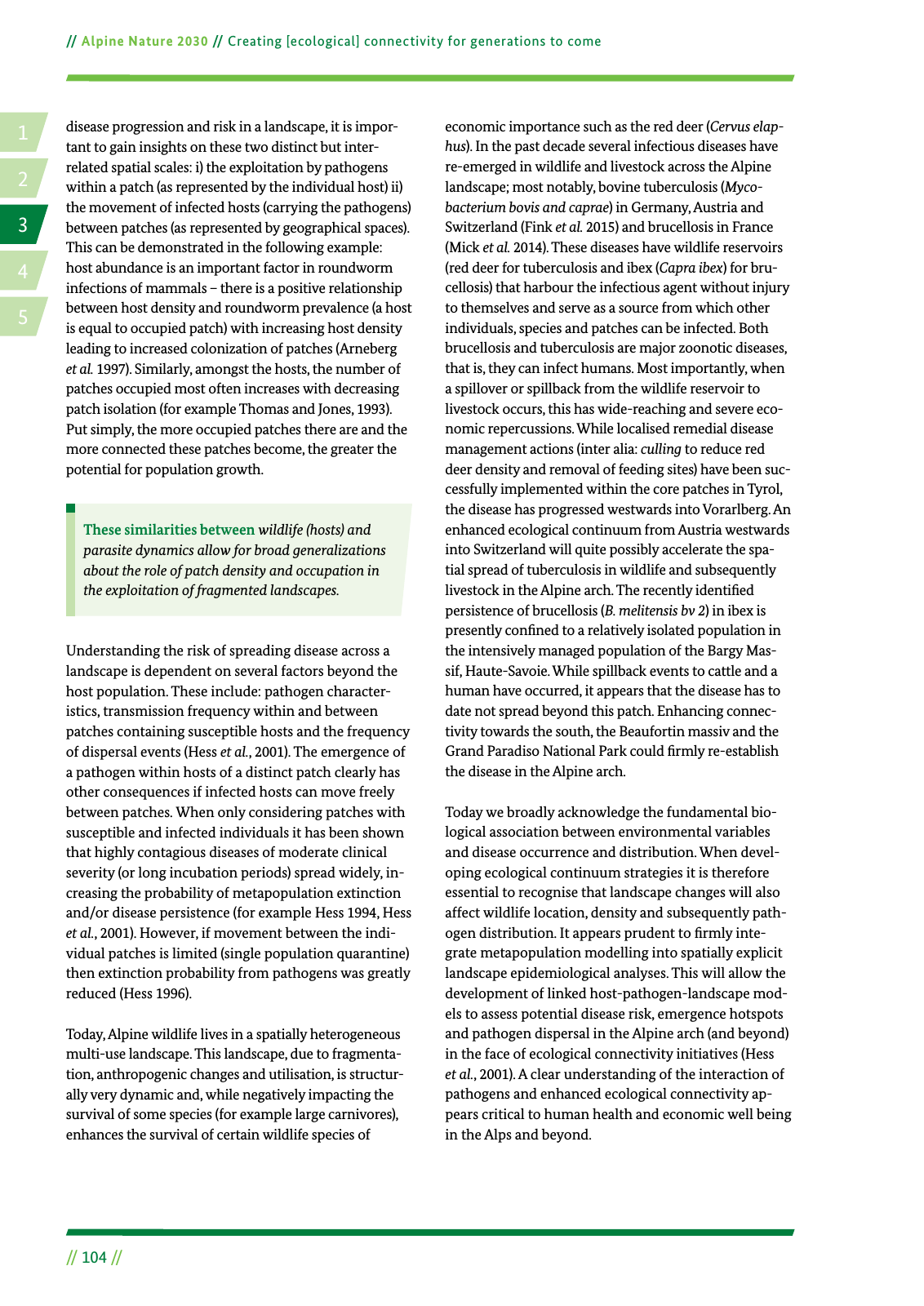14 2 5 3 Alpine Nature 2030 Creating ecological connectivity for generations to come 104 disease progression and risk in a landscape it is impor tant to gain insights on these two distinct but inter related spatial scales i the exploitation by pathogens within a patch as represented by the individual host ii the movement of infected hosts carrying the pathogens between patches as represented by geographical spaces This can be demonstrated in the following example host abundance is an important factor in roundworm infections of mammals there is a positive relationship between host density and roundworm prevalence a host is equal to occupied patch with increasing host density leading to increased colonization of patches Arneberg et al 1997 Similarly amongst the hosts the number of patches occupied most often increases with decreasing patch isolation for example Thomas and Jones 1993 Put simply the more occupied patches there are and the more connected these patches become the greater the potential for population growth These similarities between wildlife hosts and parasite dynamics allow for broad generalizations about the role of patch density and occupation in the exploitation of fragmented landscapes Understanding the risk of spreading disease across a landscape is dependent on several factors beyond the host population These include pathogen character istics transmission frequency within and between patches containing susceptible hosts and the frequency of dispersal events Hess et al 2001 The emergence of a pathogen within hosts of a distinct patch clearly has other consequences if infected hosts can move freely between patches When only considering patches with susceptible and infected individuals it has been shown that highly contagious diseases of moderate clinical severity or long incubation periods spread widely in creasing the probability of metapopulation extinction and or disease persistence for example Hess 1994 Hess et al 2001 However if movement between the indi vidual patches is limited single population quarantine then extinction probability from pathogens was greatly reduced Hess 1996 Today Alpine wildlife lives in a spatially heterogeneous multi use landscape This landscape due to fragmenta tion anthropogenic changes and utilisation is structur ally very dynamic and while negatively impacting the survival of some species for example large carnivores enhances the survival of certain wildlife species of economic importance such as the red deer Cervus elap hus In the past decade several infectious diseases have re emerged in wildlife and livestock across the Alpine landscape most notably bovine tuberculosis Myco bacterium bovis and caprae in Germany Austria and Switzerland Fink et al 2015 and brucellosis in France Mick et al 2014 These diseases have wildlife reservoirs red deer for tuberculosis and ibex Capra ibex for bru cellosis that harbour the infectious agent without injury to themselves and serve as a source from which other individuals species and patches can be infected Both brucellosis and tuberculosis are major zoonotic diseases that is they can infect humans Most importantly when a spillover or spillback from the wildlife reservoir to livestock occurs this has wide reaching and severe eco nomic repercussions While localised remedial disease management actions inter alia culling to reduce red deer density and removal of feeding sites have been suc cessfully implemented within the core patches in Tyrol the disease has progressed westwards into Vorarlberg An enhanced ecological continuum from Austria westwards into Switzerland will quite possibly accelerate the spa tial spread of tuberculosis in wildlife and subsequently livestock in the Alpine arch The recently identi ed persistence of brucellosis B melitensis bv 2 in ibex is presently con ned to a relatively isolated population in the intensively managed population of the Bargy Mas sif Haute Savoie While spillback events to cattle and a human have occurred it appears that the disease has to date not spread beyond this patch Enhancing connec tivity towards the south the Beaufortin massiv and the Grand Paradiso National Park could rmly re establish the disease in the Alpine arch Today we broadly acknowledge the fundamental bio logical association between environmental variables and disease occurrence and distribution When devel oping ecological continuum strategies it is therefore essential to recognise that landscape changes will also affect wildlife location density and subsequently path ogen distribution It appears prudent to rmly inte grate metapopulation modelling into spatially explicit landscape epidemiological analyses This will allow the development of linked host pathogen landscape mod els to assess potential disease risk emergence hotspots and pathogen dispersal in the Alpine arch and beyond in the face of ecological connectivity initiatives Hess et al 2001 A clear understanding of the interaction of pathogens and enhanced ecological connectivity ap pears critical to human health and economic well being in the Alps and beyond

Hinweis: Dies ist eine maschinenlesbare No-Flash Ansicht.
Klicken Sie hier um zur Online-Version zu gelangen.
Klicken Sie hier um zur Online-Version zu gelangen.